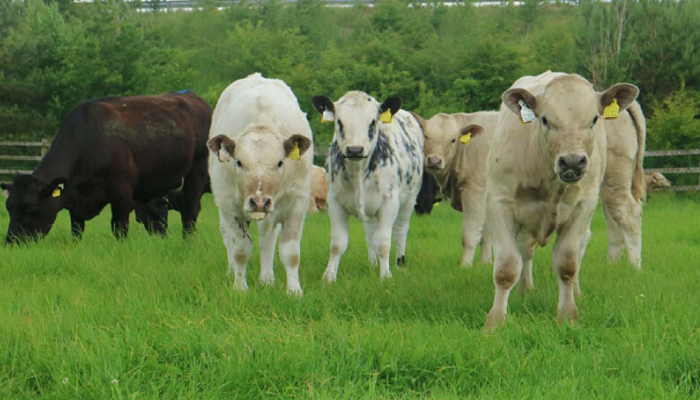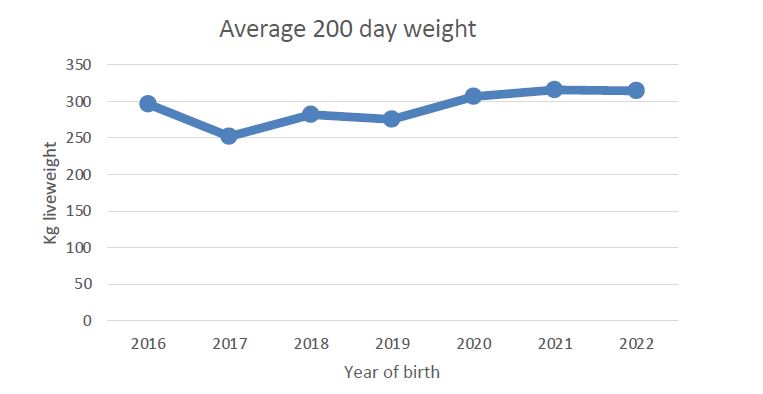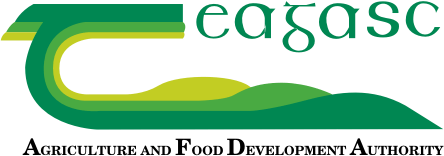23 May 2023
Watch: Optimising animal performance to achieve a younger age of slaughter at Newford

Attendees at today’s open day at Newford heard how a focus on grassland management, genetics and optimising animal performance is resulting in a reduction in slaughter age.
Irish agriculture is obliged to reduce greenhouse gas (GHG) emissions by 25% by 2030, as set out in the Climate Action Plan.
One of the many strategies being targeted to achieve this is the reduction in the age of slaughter of animals on beef farms by three months, moving from an average of 27 months back to 24 months.
This three month reduction in slaughter age will generate a reduction in the quantity of emissions from the national beef herd, delivering up to 0.7 million tonnes of GHG emissions reductions. The primary way in which this can be achieved is by ensuring animal performance levels are optimised from grazed pasture and high-quality silage at farm level, something which Newford farm has been working on since 2015. The improvements in animal performance witnessed at farm level have led to a reduced age of slaughter, whilst still meeting market specifications.
Finishing performance
In 2021, there were 40 heifer calves born on the farm. They were at grass until the 7th of December 2021, achieving an average weight of 379kg at housing. They were fed 2kg/head/day over the 44 day winter period and ad-lib silage (75% DMD). In total, these animals were fed just 256kg of meal at a cost of €88 in their lifetime. They were turned out to grass on the 20th of January 2022. The first group of 20 heifers were drafted for slaughter on the 4th of August 2022, with a further 10 finished on August 31st 2022. The remaining heifers were finished by the 11th of November 2022. Last year, the steers were finished at 21 months on average, with a carcass weight of 355kg. As can be seen in Table 1, in 2022 there were 26 cows culled on the farm. This was much higher than normal, as eight of these cows tested positive for tuberculosis and were removed from the farm in July. Hence, this has resulted in a reduced carcass weight overall and an artificially high number in 2022.
Donal Fahy, research technician at Newford Farm Athenry County Galway, outlines how they have achieved younger age of slaughter on the farm, at Newfod Suckler Open Day 2023.
Table 1: 2022 farm slaughter performance
| Steers | Heifers | Cull cows | |
|---|---|---|---|
| Number | 42 | 40 | 26 |
| Average slaughter date | 27/10/2022 | 18/08/2022 | 07/08/2022 |
| Average months | 21 | 18 | 75 |
| Carcass weight | 355 | 296 | 319 |
| Average grade | R=3- | R- 3= | 0=4- |
| Average kill out | 53% | 52% | 48% |
| Average price/kg | €5.03 | €5.06 | €4.39 |
| Total value | €1,786 | €1,507 | €1556 |
The average carcase weight of the 2021-born heifers was 296kg, at an average age of under 18 months. Similar carcass weights were achieved in heifers finished on the farm at the start of the project, but they were finished three months later at 21 month of age and with 264kg/head of additional concentrates being fed. The 2017-born heifers were sold live off the farm due to drought conditions in 2018.
Table 2. Heifer slaughter performance
| Year of birth | 2015 | 2016 | 2018 | 2019 | 2020 | 2021 |
|---|---|---|---|---|---|---|
| Grade | R+4- | R=4- | R=3= | R=3= | R=3- | R–3= |
| Carcass weight (kg) | 296 | 291 | 299 | 299 | 311 | 296 |
| Live weight (kg) | 574 | 560 | 569 | 570 | 583 | 564 |
| Kill out % | 52% | 52% | 53% | 52% | 53% | 52% |
| Age (months) | 20 | 19 | 20 | 20 | 20 | Under 18 |
| Value (€) | €1,176 | €1,167 | €1,117 | €1,188 | €1,396 | € 1,507 |
| Price/Kg | €3.97 | €4.01 | €3.74 | €3.97 | €4.49 | €5.06 |
Last year, the steers were finished just before Christmas at under 21 month, achieving an average carcass weight of 355kg as shown in Table 3. This is an 18kg increase in carcass over the project and a decrease in concentrates of 83kg/head.
Table 3. Steer slaughter performance
| Year of birth | 2015 | 2016 | 2017 | 2018 | 2019 | 2020 | 2021 |
|---|---|---|---|---|---|---|---|
| Grade | R=3= | R-3+ | R=3+ | R+3= | R=3- | R=3- | R=3- |
| Carcass weight (kg) | 337 | 341 | 367 | 350 | 350 | 357 | 355 |
| Live weight (kg) | 652 | 653 | 685 | 642 | 647 | 663 | 670 |
| Kill out % | 52% | 52% | 54% | 55% | 54% | 54% | 53% |
| Age (months) | 19 | 21 | 21 | 21 | 20 | 21 | 21 |
| Value (€) | €1,305 | €1,400 | €1,434 | €1,315 | €1,389 | €1,611 | €1,786 |
| Price/Kg | €3.87 | €4.10 | €3.90 | €3.76 | €3.96 | €4.51 | €5.03 |
The improvements achieved are arising from: improvements in genetics, through improved terminal beef sires used on a more mature cow herd; and improved animal performance from better grassland management, as well as increased grazing season length, resulting in better nutrition and animal health.
Calf performance
Excellent growth rates are being achieved by the calves in the herd. This can be attributed to:
- Suckler cows that calve compactly at the start of the grass growing season and have high milk yields;
- Good herd health and stock management throughout all stages of the year;
- Selecting AI sires with good terminal traits, leading to heavier weaning weights;
- Selecting replacements with good maternal traits, with an emphasis on good milk yield to drive weaning weight;
- Excellent grassland management to ensure that cows are producing milk, so that calves meet their full growth potential.
The average 200 day weight of the weanlings on the farm is outlined in Figure 1. In 2022, the bulls 200 day weight was 318kg, with an average daily gain of 1.36kg/head/day. The heifers weighed 308kg and gained 1.33kg/head/day. Since 2016, the average 200 day weight figure has increased by 19kg from 296kg to 315kg on the farm.
Figure 1: Average 200 day weight (Kg)

The Newford Farm was established by Teagasc and Dawn Meats, with the support of McDonald’s and the Irish Farmers Journal, to demonstrate best practice in sustainable suckler beef production. This article first appeared in the Newford Suckler Open Day book. Access the full book here.
